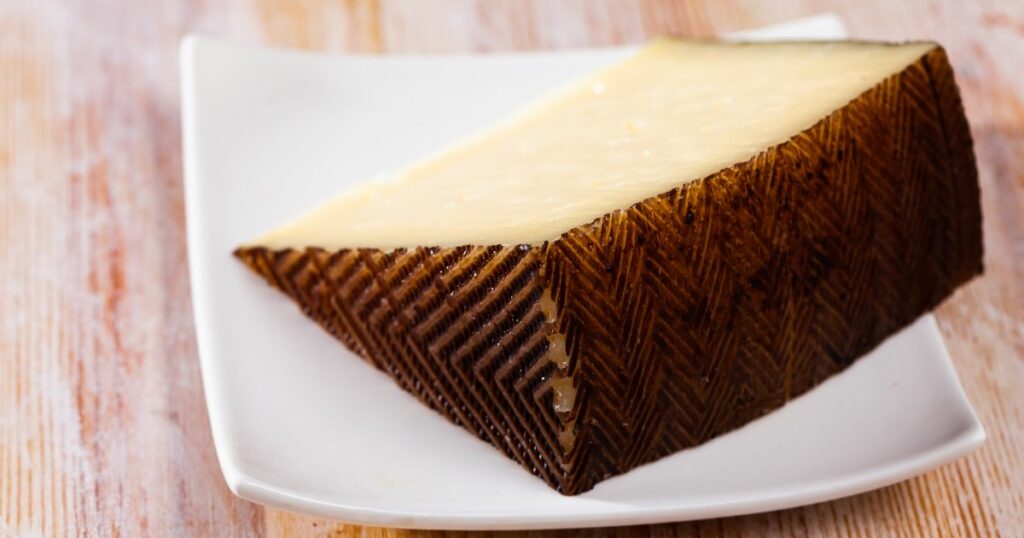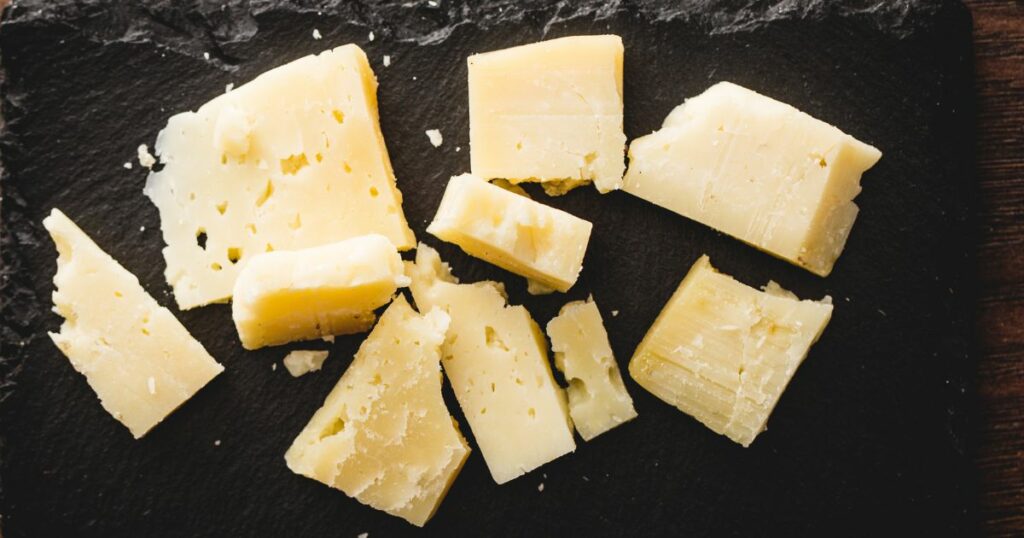Manchego: The Quintessential Spanish Cheese

Manchego, Spain’s most famous cheese, hails from the La Mancha region, the land of Don Quixote. Made exclusively from the milk of Manchega sheep, this cheese is aged for varying lengths of time, resulting in different flavours and textures. A young Manchego is mild and creamy, while an aged one offers a firmer texture and more intense flavours. The taste is buttery with a hint of nuttiness, and a crumbly texture that melts in your mouth.
Classic pairing: Sliced green apples or pears, the natural sweetness and crunch of apples or pears provide a refreshing contrast to the savory, nutty flavours of Manchego.
Cabrales cheese: Bold and Blue

Cabrales, a blue cheese from Asturias, is not for the faint of heart. Made from a blend of cow, sheep, and goat milk, this cheese is cave-aged for up to six months, resulting in a strong, pungent flavour and a rich, creamy texture. Cabrales offers a spicy, slightly sour taste that intensifies as it lingers on the palate, making it a favorite among blue cheese aficionados.
Classic pairing: Drizzling honey over the bold, pungent Cabrales creates a delightful sweet and savory experience that balances the cheese’s intensity.
Tetilla Cheese: A Taste of Galicia

Tetilla, named for its distinctive breast-like shape, is a mild, creamy cheese from Galicia in northwest Spain. Made from cow’s milk, Tetilla has a smooth, buttery texture and a slightly tangy taste that makes it perfect for snacking or melting. Its delicate flavour profile and supple texture have made it a beloved cheese throughout Spain.
Classic pairing: The crispness of crackers and the juicy sweetness of grapes complement the mild, creamy flavours of Tetilla.
Mahón Cheese: The Jewel of the Balearic Islands

Originating from the island of Menorca, Mahón is a cow’s milk cheese that ranges from mild and creamy when young, to sharp and salty when aged. The rind, rubbed with olive oil and paprika, gives the cheese its distinctive orange hue. The interior is pale yellow and has a slightly crumbly texture with a taste that can be buttery, nutty, or tangy depending on the aging process.
Classic pairing: Sliced baguette and sun-dried tomatoes, the combination of crusty and tangy highlights the buttery, nutty flavours of Mahón.
Garrotxa Cheese: Catalonia’s Mountain Gem

Garrotxa, a semi-firm goat’s milk cheese from Catalonia, is named after the volcanic region where it is produced. With a natural, greyish rind and a dense, ivory-coloured interior, this cheese has a complex flavour profile that is earthy, nutty, and slightly herbaceous. Garrotxa’s smooth, velvety texture makes it a favorite on cheese boards and in cooking.
Classic pairing: Olive tapenade and toasted bread, the briny, their rich flavours provide a savory accompaniment to the earthy, nutty notes of Garrotxa.
Iberico Cheese: The Taste of Three Milks

Iberico is a unique Spanish cheese made from a blend of cow, sheep, and goat milk. Hailing from the La Mancha region, Iberico is often compared to Manchego due to its similar shape and production process. However, the combination of three milks gives Iberico a distinct flavour profile that is mild, buttery, and slightly tangy. The cheese’s smooth, firm texture makes it a versatile choice for snacking or cooking.
Classic pairing: Figs with their natural sweetness coupled with the saltiness of serrano ham enhance the mild, buttery flavours of Iberico cheese.
Idiazábal Cheese: A Smoky Basque Delight

Idiazábal is a firm, unpasteurised sheep’s milk cheese from the Basque Country and Navarre. Known for its smoky flavour and slightly oily texture, Idiazábal is often smoked over beechwood, hawthorn, or cherry, which imparts a unique taste. The cheese’s flavour is buttery and nutty, with a hint of tanginess.
Classic pairing: Roasted nuts with their crunch and natural sweetness with dried apricots to complement the smoky, tangy flavours of Idiazábal.
Valdeón Cheese: A Hidden Blue Treasure

Queso de Valdeón is a blue cheese from the Valdeón Valley in the province of León, Spain. Made from a mix of cow’s and goat’s milk, this cheese is wrapped in sycamore leaves and aged in mountain caves. Queso de Valdeón has a creamy, slightly crumbly texture with a bold, spicy, and slightly sweet flavor profile, making it an excellent choice for blue cheese lovers.
Classic pairing: The natural sweetness of pear slices and the earthy crunch of walnuts make an excellent pairing for the bold, piquant flavors of Queso de Valdeón. The combination of sweet and spicy creates a harmonious and memorable experience.
Zamorano Cheese: The Bold Flavour of Castile and León

Zamorano is a sheep’s milk cheese from the Castile and León region of Spain. Similar in appearance to Manchego, Zamorano is made exclusively from the milk of Churra and Castellana sheep. It boasts a firm, crumbly texture and a nutty, slightly piquant flavour. The aging process, which lasts between 4 and 12 months, enhances the cheese’s complex taste.
Classic pairing: Cured chorizo with its spicy, smoky flavours and the hearty crunch of crusty bread create a satisfying match for the bold taste of Zamorano.
Queso Fresco de Burgos: A Versatile Fresh Cheese

Queso Fresco de Burgos is a fresh, unaged cow’s milk cheese from the Burgos province in the Castilla y León region of Spain. This cheese has a soft, spreadable texture and a clean, mild flavor with a hint of tanginess. Queso Fresco de Burgos is perfect for a variety of dishes, from sweet to savory, and can be enjoyed on its own or as an ingredient in recipes.
Classic pairing: For a savory option, serve Queso Fresco de Burgos with tomato bruschetta on toasted bread and a drizzle of olive oil. The fresh, bright flavors of the tomatoes, the crunch of the bread, and the richness of the olive oil complement the cheese’s mild, creamy taste.
Conclusion
In conclusion, Spain’s rich cheese-making heritage offers a diverse and flavorful array of cheeses, each with its own unique characteristics, textures, and tastes. From the bold and piquant flavors of blue cheeses like Cabrales and Queso de Valdeón to the mild, creamy delights of Queso Fresco de Burgos, there is a Spanish cheese to suit every palate. The classic and alternative pairings provided for each cheese in this list offer a range of options to explore and enjoy these Spanish delicacies, whether as part of a cheese board, a light snack, or a more elaborate culinary creation. So, the next time you’re looking to expand your cheese horizons or simply indulge in some delicious Spanish flavors, don’t hesitate to try one or more of these exceptional Spanish cheeses and their delightful pairings.
𐡸 𐡸 𐡸 𐡸 𐫱 𐡷 𐡷 𐡷 𐡷
Frequently asked questions
Manchego, a sheep’s milk cheese from La Mancha, is arguably the most popular and well-known cheese in Spain.
Yes, many of these Spanish cheeses can be found at specialty cheese shops, gourmet food stores, and even some supermarkets outside of Spain. Availability may vary depending on the country and region.
Spanish cheeses are made from a variety of milk sources, including cow’s milk, goat’s milk, and sheep’s milk. Some cheeses are even made from a blend of two or more types of milk.



